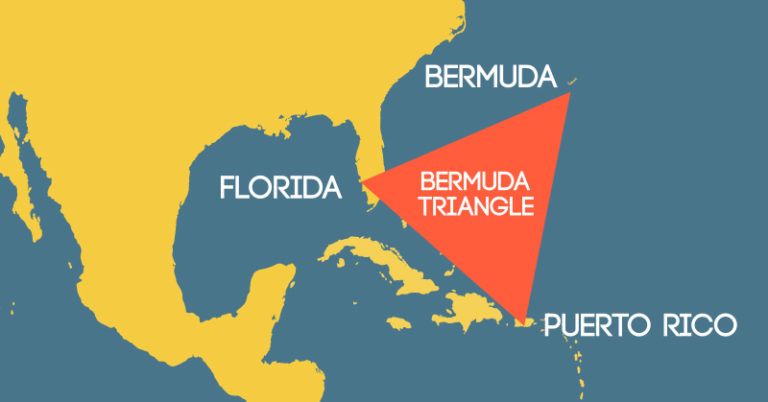The Bermuda Triangle is a section of the Atlantic Ocean between Miami, Bermuda, and Puerto Rico. Throughout the last several decades, dozens of ships and airplanes have supposedly disappeared here. For this reason, this mysterious area has become infamous around the world [1].
For years, experts have been attempting to solve the mystery of the Bermuda Triangle, but none have succeeded- until now. The answer, however, is decidedly less exciting than the riddle. As it turns out, there was never any mystery to solve in the first place.
The Mystery of the Bermuda Triangle
The mystery of the Bermuda Triangle, or as some call it, the “Devil’s Triangle”, started with none other than Christopher Columbus.
Columbus was sailing through the area on his first voyage to the New World when he reported a strange occurrence one night. According to his account, a “great flame of fire” crashed into the sea. Experts believe that this was likely a meteor. A few weeks later, a strange light appeared in the distance.
The explorer also reported erratic compass readings in the region. Some researchers believe that this may have been because of where the Bermuda Triangle was. It was possible that at that time, a sliver of the triangle was one of the places on earth where “true north” and “magnetic north” line up.
The mysterious ocean region, however, did not gain infamy until the twentieth century. At this time, reports of unexplained disappearances of ships and boats began to circulate widely.
One such tragedy occurred in 1918. A massive Navy cargo ship, the USS Cyclops, was carrying over three hundred men and ten thousand tons of manganese ore when it sank somewhere between Barbados and the Chesapeake Bay. It never sent out a distress signal before it went down, and no one ever found the wreckage despite extensive searching.
Nearly thirty years later, two of the Cyclops’ sister ships also disappeared along the same route.
During the ensuing years, reports of other mysterious disappearances began to occur. These reports were not only about ships travelling through the area’s perilous waters, but aircraft as well.
In 1945, five Navy Bombers carrying fourteen men were flying through the area when the leader of the mission’s compass apparently began malfunctioning. All five planes got lost and eventually had to ditch at sea when their planes ran out of fuel. The rescue plane that came to save them also disappeared with no trace. The official Navy report of the incident said it was “as if they’d flown to Mars”.
What’s the Real Science Behind the Bermuda Triangle?
Since those events occurred, many researchers and amateur enthusiasts have attempted to solve the mystery of the Bermuda Triangle.
In 2016, a documentary on the Science Channel suggested that hexagonal clouds are the reason behind the vanishing vessels. These clouds apparently create winds of 106 kilometers per hour (65 miles per hour) that act as “air bombs”. These can sink ships and crash planes [2].
Other theories have suggested that it is because of sinkholes, whirlpools, or massive waves in the area that swallow everything in their path [3].
According to journalist Larry Kusche, the reason why no one has been able to prove any of these hypotheses is because the Bermuda Triangle doesn’t actually exist.
In his book “The Bermuda Triangle Mystery- Solved”, Kusche thoroughly examined the facts of the supposed disappearances. What he found was that mistakes made up most of the story, along with mystery mongering and occasional complete fiction.
The journalist determined that most of the people who wrote on the topic failed to do any actual investigative work. Instead, they merely repeated accounts of writers before them, who had done the same.
In fact, he found that the man who popularized the mystery, Charles Berlitz, had based his story on mistakes. Kusche was appalled by the sloppiness of Berlitz’ reporting.
“If Berlitz were to report that a boat were red, the chance of it being some other color is almost a certainty,” Kusche said [4].
A Mystery of Misinformation
In 2012, Benjamin Radford wrote on the topic for Live Science. He described how the majority of Berlitz’s stories were near-complete fabrications.
“In some cases there’s no record of the ships and planes claimed to have been lost in the aquatic triangular graveyard; they never existed outside of a writer’s imagination,” Radford wrote. “In other cases, the ships and planes were real enough — but Berlitz and others neglected to mention that they “mysteriously disappeared” during bad storms.” [4]
He also noted that in many cases, the ships in question sank far outside the Bermuda Triangle. Additionally, dozens of cruise and cargo ships travel through this area regularly. This, Radford says, makes it a mere numbers game.
“Logically, just by random chance, more ships will sink there than in less-traveled areas such as the South Pacific.” [4]
The Legend Persists
Experts have known for decades that the “mystery” of the Bermuda Triangle didn’t really exist. The legend, however, has persisted nonetheless. Today, most of us still think of the Bermuda Triangle as this dangerous area shrouded in secrets and unanswered questions.
The truth is, most of us prefer a fascinating legend over no story at all. For this reason, many authors have continued to write about the sensational story, and many of us have continued to lap it up.
While it may be thrilling to think about a magical area on earth that causes ships and planes to disappear, the truth exists. The Bermuda Triangle does not.
Sources:
- ‘Bermuda Triangle’ History. Published August 28, 2018.
- ‘Experts Claim They Might Have ‘Solved’ The Bermuda Triangle Mystery’ Science Alert Fiona MacDonald. Published October 21, 2016.
- ‘Truth behind Bermuda Triangle – mysterious region which has swallowed 300 ships, a fleet of fighter jets and a flying boat’ Mirror Claire Carter. Published July 28, 2017.
- ‘Bermuda Triangle: Where Facts Disappear’ Live Science Benjamin Radford.

